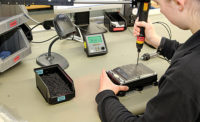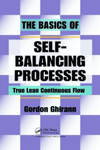What torque should be used to tighten a threaded fastener? To answer this question, engineers must first understand the purpose of torque in installing threaded fasteners. Fasteners are typically used for three major reasons: to hold two or more components together, to allow for disassembly at a later time, and to provide a high level of clamp force.
It is for this last reason, high clamp force, that threaded fasteners are typically selected over other fastening means. It surprises many people to learn that a 1⁄4-inch diameter fastener can easily supply 3,000 to 4,000 pounds of clamp force.
When tightening a threaded fastener, the goal is to produce enough clamp force to prevent joint failure. The clamp force that can be produced and maintained within a joint is influenced by the fastener design, joint design, assembly procedure and the environment in which the product is placed. Of these influences, the chief cause of inappropriate clamp force is the procedure used to tighten the fastener.
Torque is the force applied to rotate the fastener into the joint. As the joint comes together, several events take place simultaneously:
- The amount of torque needed to continue rotation increases;
- The fastener starts to stretch under a tensile force, also known as the preload; and
- The joint is squeezed together with an opposing clamp force.
What torque should be used to tighten a threaded fastener? The answer is the one that provides the correct preload on the fastener and thus the appropriate clamp force in the joint. Otherwise, just one incorrectly tightened bolt or screw can lead to the failure of the complete product. Consult a fastener specialist to determine the clamp force and seating torque your joint requires.
The Torque-Control Method
Torque-controlled tools are the most popular tools for tightening threaded fasteners. These tools shut off at a predetermined torque value, with the goal of producing a specific clamp force on the joint. These tools stop fastener rotation at a target torque value that is associated with a known fastener preload. This target torque is commonly called the seating torque.The key to the torque-control method is determining the relationship between the assembly torque and the fastener’s tension or preload, and understanding how this relationship can vary. If there were no variation in the torque-tension relationship, the torque-control method would be an accurate way of obtaining the target clamp force. Unfortunately, the torque-tension relationship can vary easily, so the torque-control method is an imprecise way of obtaining a target clamp force.
Using the torque-control method, the fastener preload, and thus the clamp force on the joint, can vary by as much as ±35 percent. The main cause of this imprecision is that only a small portion of the applied torque is actually used to produce fastener preload.
Tightening a threaded fastener is basically an energy transfer process. Energy in the form of torque is used to tighten the fastener. This energy is transferred to several areas. On a typical threaded joint, only 5 percent to 20 percent of the torque is used to stretch the fastener. The other 80 percent to 95 percent of the torque is used to overcome friction between the fastener and the parts.
There are two areas where this friction occurs:
- The mating surface between the fastener threads and nut threads; and
- The mating surface between the joint and the fastener head and nut.
If torque-controlled tools are so imprecise, why do so many assemblers use them? Torque-controlled tools remain the most common assembly tools because they are relatively economical and easy to use compared with more precise tools. These other tools may produce ±7 percent to ±15 percent variation in preload, but are more costly and require certain controlled joint conditions. Also, precise preload control is not needed for noncritical joints or for products that have been overdesigned for strength, leaving a wide safety margin for clamp forces.
Of course, engineers don’t always have the luxury of overdesigning a joint. Indeed, fastened joints in today’s small, lightweight products are typically less robust and more sensitive to clamp force variations. Consequently, torque selection should be based upon the joint’s sensitivity to clamp force.
Seating Torque for Sensitive Joints
Some joints, such as structural hard joints, actually behave as mechanical devices that require a high level of clamp force to function correctly. In such cases, the reliability of the product is partially established by maintaining a targeted clamp force within the joint.To make the best use of torque control to achieve a target clamp force, engineers need to determine the optimal seating torque. To do this, engineers need to understand the relationship between torque and tension.
Ideally, the torque-tension relationship is determined by testing the actual joint components under "production" conditions. The test should be designed in such a way that assembly torque and fastener preload are recorded as the fastener is tightened to failure.
This information can be plotted on a graph with the preload on the Y axis and torque on the X axis. With the resulting curve, called a signature curve, engineers can easily determine what seating torque will provide the target preload, and thus the clamp force needed to maintain a reliable joint. The fastener is typically tightened somewhere within the upper linear region of the signature curve.
Determining the Nut Factor
It’s not always convenient to plot a signature curve for a specific torque-tension relationship. Fortunately, this relationship can be easily conveyed through an engineering variable called the nut factor.The nut factor is a single number that reflects the slope of the linear portion of the torque-tension signature curve. Other names for the nut factor are the "K" factor or the torque coefficient. Knowing the slope allows engineers to calculate what torque will produce a target preload, or what preload is obtained from a given torque.
This can be done with the following equation:
T = K x D x W, where
T = Torque
K = Nut factor (dimensionless)
D = Fastener nominal diameter
W = Fastener preload
Note that the nut factor is a dimensionless unit. The units for torque, preload and nominal diameter cancel each other out, so that the nut factor remains dimensionless. Using basic algebra, the equation can be revised to solve for preload or nut factor. In the examples below, the nut factor remains equal to 0.2. Torque and preload change, but remain true to the signature curve.
T = K x D x W
100 in.-lb = 0.2 x 0.25 inch x 2,000 pounds
K = T ? (D x W)
0.2 = 150 in.-lb ? (0.25 inch x 3,000 pounds)
W = T ? (D x K)
4,000 pounds = 200 in.-lb ? (0.25 inch x 0.2)
The nut factor is originally derived by picking a point within the linear region of the torque-tension signature curve. This is because the nut factor only represents the slope of this line. It does not represent the curved areas, which indicate that the fastener is embedding into the joint material or that the fastener has reached a post-yield condition. The equation is, therefore, only accurate for this linear region.
The fastener’s nominal diameter is built into the nut factor. This means that under the same friction variables, the nut factor will remain the same regardless of fastener size. This fact makes the nut factor a universal engineering variable that can easily cover a broad range of products.
When using the nut factor, engineers must realize that there is a significant amount of variation within the torque-tension relationship, even when the joint and assembly operation remain unchanged. This is mainly because there are always subtle changes in friction within the materials and the assembly process. For this reason, engineers usually talk of an expected range of nut factor variance for a particular assembly procedure.
If there is a major change to the components or process that make up a joint, there will be a substantial change in friction, as well as the nut factor. For this reason, the nut factor range should always be initially established through testing.
For any given joint design, the nut factor can vary by as little as 0.02 or as much as 0.15. For different joint designs, the nut factor can vary by as little as 0.1 or as much as 0.55.
Once engineers become accustomed to using the nut factor and how different variables can affect it, they can estimate its range if they know the contributing factors. Some of the main contributing variables are the bearing surface the joint provides to the fastener; the nut material; the type and speed of fastening tool; the fastener material and finish; and the configuration of the fastener head and nut. The nut factor will change significantly if any of these variables change.
For more information about setting torque specifications, call 800-544- 6117 or visit www.textronfasteningsystems.com.







